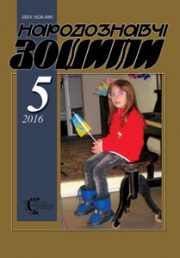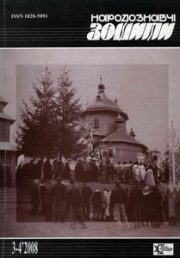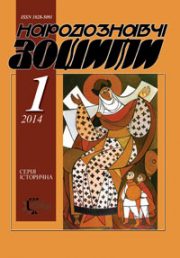The Ethnology Notebooks. 2024. № 2 (176), 377—389
UDK 730.036.45.071.1″18/19″
DOI https://doi.org/10.15407/nz2024.02.377
TYPOLOGY OF PLASTIC SHAPE IN ALEXANDER ARCHIPENKO’S ART
KLYMENKO Mariya
- ORCID ID: https://orcid.org/0000-0002-7792-3714
- Contacts: e-mail: klymenkomary@gmail.com
Abstract. The stages of Alexander Archipenko’s (1887—1964) formation from the early symbolism to different stages of experimental shape were underlined. The goal of the article is to identify the features of Archipenko’s worldview through the systematization of his plastic shapes typology. The main task of our research is disclosing the specifics of Archipenko’s shape concepts and their typologies. To reveal goals and tasks in the scope of object and subject research the methods of scientific reconstruction and interpretation, phenomenological and
comparative approach, structural and typological analysis were used. The phenomenology method was used in order to avoid stereotypes existed by the figure of the sculptor which promoted the phenomenon of the artist up to date. Due to the underlining the main problem of the research, particularly the question of the typology of Archipenko’s plastic shapes, another angle of representation of the well-known personality of the artist was found. The method of the formal and figurative analysis of works was used to find and discover the complete picture of the sculptor’s creative work in order to follow the typology of Archipenko’s plastic shapes.
Results. The scientific reconstruction of the dynamics of changes of the artist’s figurative means in the context of confirmation of his individual conceptual and philosophic line was done. The importance of his personality is determined by a great number of multi-vector directions of his art. Nevertheless, even because of it, the individual figurative and plastic language differs Archipenko from other contemporaries and followers.
Conclusions. In the process of the research another angle of the presentation of Archipenko’s phenomenon was found. As a result of our work the evolutionary
typology of Archipenko’s plastic shape was established.
Practical use of the research. Archipenko creative heritage can be served a valuable resource in the search of modern artistic concepts.
Keywords: Alexander Archipenko’s art, 20th century, sculpture, typology of plastic shape, European Avant-garde, Modernism, Cubism, concept of the plastic shape.
Received 30.03.2024
REFERENCES
- Dellis, A.B. (Ed.). (1970). Archipenko: the American Years, 1923—1963. Bernard Danenberg Galleries. New York.
- Archipenko, A., & fifty art historians. (1960). Archipenko: Fifty Creative Years 1908—1958. New York: TEKHNE.
- Michaelsen, K.J., & Guralnik, N. (Eds.). (1987). Alexander Archipenko 1887—1964. Alexander Archipenko, a centennial tribute. Washington; Tel Aviv.
- Wight, F.S. (1967). Alexander Archipenko: A Memorial Exhibition, 1967—1969. UCLA Art Galleries.
- Synko, O. (1996). Alexander Archipenko’s art at the first quarter of the 20th century. Candidate’s thesis. Rylsky Institute of Art Studies; Folklore and Ethnology. Kyiv [in Ukrainian].
- Olenska-Petryshyn, A., & Kachurovsky, V. (Eds.). (1973). Archipenko. Chicago: Ukrainian Institute of Modern Art [in Ukrainian & English].
- Pevny, B. (1992). Archipenko’s roots. Modernity, 9, 127—140 [in Ukrainian].
- Leshko, J. (Ed.). (2005). Alexander Archipenko. Vision and continuity. New York: The Ukrainian Museum [in Ukrainian & English].
- Hildebrandt, H. (1923). Alexander Archipenko. Berlin: Ukrainske slovo [in Ukrainian].
- Petrova, O. (2001). Alexander Archipenko’s «Spatial pauses» are the phenomenon of the mystery. Stored in Ukraine. Alexander Archipenko. «Archipenko and the world culture of the 20th century». Kyiv: National Art Museum of Ukraine [in Ukrainian].
- Popovych, V. (1977). Archipenko in France. Notatky z mystetstva, 17, 5—18 [in Ukrainian].
- Alexander Archipenko. (1933). Svoboda (Part 293, pp. 2—3). Retrieved from: https://www.svoboda-news.com/arxiv/pdf/1933/Svoboda-1933-293.pdf [in Ukrainian].
- Lysytsky, E. (1922). Exhibition in Berlin. Veshch, 3, 14. Retrieved from: https://monoskop.org/images/6/6a/Veshch_Gegenstand_Objet_3_May_1922_lores.pdf [in Russian].
- Archipenko Gray, F. (2014). My life with Alexander Archipenko. Munich: HIRMER.
- Archipenko, O. (1934). MВ. Novyi chas (Part 264, p. 8) [in Ukrainian].
- Fedorovych-Malytska, I. (1935). Testament of the future. Dilo (Part 304, p. 4). Retrieved from: https://libraria.ua/numbers/192/20784/?PageNumber=8&ArticleId =772170 &Search=molody%20teatr [in Ukrainian].
- Holubets, O. (2020). The magic of the third dimension: skulpture plastic of the end of the 19th — beginning of 20th century. Lviv: Kolir PRO [in Ukrainian].
- Cendrars, B., Daubler, T. & Goll, I. (1921). Archipenko-album. Potsdam: G. Kiepenheuer Verlag [in German].
- Calhoun, D.R. (2016). Dynamism, creativeness, and evolutionary progress in the work of Alexander Archipenko. Doctoral dissertation. The Ohio State University. Columbus. Retrieved from: https://etd.ohiolink.edu/!etd.send_file?accession=osu1 460755467& disposition=inline
- Hordynsky, S. (1948). Archipenko’s exhibition. Svoboda, 108, 2. Retrieved from: http://www.svoboda-news.com/arxiv/pdf/1948/Svoboda-1948-108.pdf [in Ukrainian].
- (1951). Archipenko in Metropolitan Museum in New York. Svoboda (Part 294, p. 1). Retrieved from: http://www.svoboda-news.com/arxiv/pdf/1951/Svoboda-1951-294. pdf# search =”archipenko” [in Ukrainian].
- (1952). Art chronicle. Archipenko explains his art. Svoboda (Part (51), p. 4). Retrieved from: https://www.svoboda-news.com/arxiv/pdf/1952/Svoboda-1952-051.pdf [in Ukrainian].
- (2015). Archipenko: a modern legacy. Washington, DC: International Arts & Artists.
- Bukoyemska, I. (1987). Studying at Archipenko… Suchasnist (Part 5 (313), pp. 48—53). Retrieved from: http://shron2.chtyvo.org.ua/Suchasnist/1987_N05_313.pdf [in Ukrainian].
- Keiser, A. (2006). Creative spirit: Alexander Archipenko’s contribution. The Tretyakov Gallery Magazine, 2, 62—67.
- Archipenko, O. (1955). Philosophy of art. Ukrainska literaturna gazeta (Part 4, p. 4). Retrieved from: https://diasporiana.org.ua/periodika/17956-ukrayinska-literaturna-gazeta-1955-ch-4/ [in Ukrainian].







